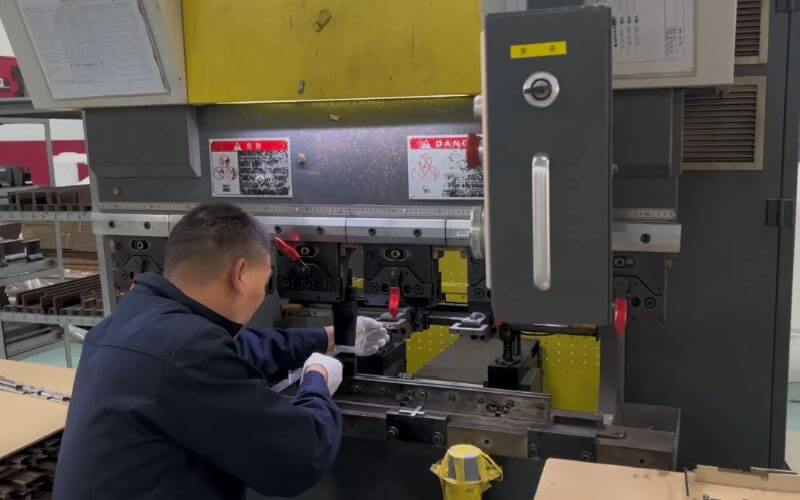
Assembly is not always thought of as a manufacturing process. However, assembly is critical to the overall manufacturing process. Operators use fasteners such as bolts, rivets, and screws in the assembly of various sheet metal components. Throughout the sheet metal manufacturing process, operators may use processes such as punching to create holes for rivets, pins, and other fasteners. Key assembly processes include welding, riveting, brazing and the use of adhesives.
Welding is the use of heat to melt one piece of metal so that it intersects with another piece, with the addition of a filler material. The molten parts fuse together. Different types of welding, such as arc welding, MIG welding, TIG welding, etc., have different weldability for different metals. Welding has a wide range of applications, including joining metals, plastics and wood.
In the process of joining metals, welding uses high temperatures to melt the base metal and usually adds a filler material. The high temperatures melt the weld, which then cools to form the joint. The weld can be stronger than the parent metal. Operators can form welds using pressure in some cases, either by applying pressure alone or in combination with heat. Operators can also use shielding gases to protect the molten metal and filler metal from oxidation or contamination.
Operator also use heat to join plastics in a three-step process. First, operators pre-treat the surfaces before applying pressure and heat. Next, they apply heat and pressure to fuse the materials together. Finally, they cool the materials to complete the fusion process. We can divide plastic joining methods into internal heating methods and external heating methods.
When joining wood, operators generate heat through friction to join the materials together. The materials are first subjected to high pressure and then to a linear frictional movement which generates heat to join the pieces of wood together. Operators use this method to join wood without the need for nails or adhesives, and it is a quick process.
In welding, operators use various joint configurations such as the butt joint, where two parts meet at their edges, forming an inclusive angle of 135°-180°. A T-joint joins the edge or end of one part to the face of the other. The parts form an angle of up to 90°. The corner joint makes an angle between 30° and 135° as it connects the edges of two parts. The edge joint makes an angle between 0° and 30° inclusive at the joint, as it joins the edges of two parts. The cruciform joint consists of two flat plates or bars welded at right angles to a flat plate on the same axis. The lap joint joins two overlapping parts and forms an angle between 0° and 5° inclusive at the weld.
Riveting is the joining of metal sheets using small pieces of metal embedded in the sheets. Operators can drill, punch, or place rivets in holes. They then deform the rivet tail to secure the rivet in place. To achieve rivet tail deformation, operators hammer or tap the rivet tail. This action flattens the rivet material and expands the size of the rivet tail to 150% of the original diameter of the rivet shank. Operators can perform riveting using a variety of rivet configurations, such as single, double, or zigzag rivets, to create butt or overlap joints. Eight common rivet types are
Brazing is similar to welding but melts the filler metal without melting the sheets. The molten filler metal, which is a brazing alloy, solidifies in the joint. The filler metal typically melts above 450°C and should have a melting point lower than that of the parts being joined. This differs from welding, where the high temperatures cause the base metals to melt. In brazing, a flux protects the filler metal. The joint forms as the molten filler metal solidifies during cooling, creating a bond between similar or dissimilar metals.
The brazing process utilizes a variety of atmospheres, including nitrogen, ammonia, hydrogen, inorganic vapors, noble gases, and vacuum. You can use a variety of heating sources, such as furnaces or torches. You form a good brazed joint when both the filler metal and the base metal are metallurgically compatible. There should be a gap in the joint design into which the molten filler can be drawn by capillary action. The gap depends on factors such as the composition of the brazing alloy and base metal and the brazing atmosphere. Brazing is ideal for joining dissimilar metals and finds extensive use across industries due to its versatility and the integrity it imparts to the joints. This makes it reliable in critical applications.
Adhesives can be used alone or in conjunction with other methods to join sheets together. Structural adhesives can independently form the joints, while mechanical adhesives complement other joining methods. Today’s adhesive technologies allow metal fabrication without the use of welding or mechanical fasteners, while increasing joint strength and structural integrity. Innovation in adhesives is cost-effectively increasing the durability and strength of products. Unlike spot welding and fasteners that create stress points, adhesives distribute stress throughout the bonded joint. This prevents corrosion and increases fatigue resistance. Flexible adhesives have the ability to absorb stresses caused by bending, shock and vibration. This further reduces fatigue. Types of adhesives used in sheet metal fabrication include